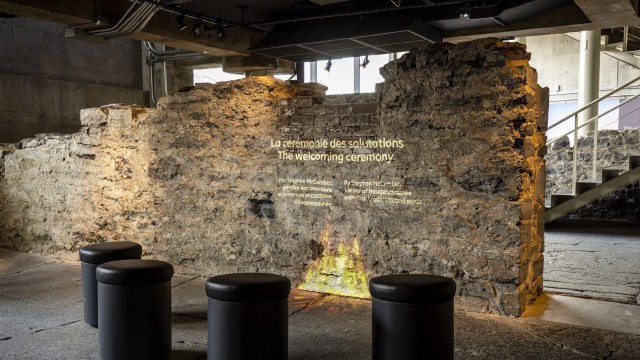First Peoples on the Point

Travel back over 12,000 years, learning about the history and cultures of Québec’s First Nations! Complex and diverse, Indigenous cultures, like all other cultures, are not frozen in time—they adapt to change and evolve as the years go by.
Learn about the two Indigenous cultural groups present on the island of Montréal in the 17th century. We will explore their cultures, their histories, their traditions, and their relationships, including a look at a major event—the Great Peace of 1701. Through archaeological remains, artefacts, and reproductions, students will get a tangible look at the traces these peoples have left behind, how their cultures adapted after colonization, and their links to the present and to today’s Indigenous descendants.
A pluricultural journey over thousands of years, highlighting the richness and importance of the history and traditions of our First Nation peoples.
What will students experience?:
- They will handle, observe, and compare remains, objects, reproductions, iconography, and models that bear witness to the ways of life of Indigenous populations.
- They will explore, ask questions, and actively participate in learning about the various nations and their histories.
- They will hear and explore the languages, stories, legends, and traditions of Indigenous peoples, past and present.
Concepts covered during the workshop
- Understanding the great complexity and diversity (languages; ways of life; economic, social, and political organization; transportation; diplomacy; trade and bartering systems; demographic and geographic realities) of the First Nations over time.
- Learn about the evolution of relationships between First Nations, Europeans, and Canadians, from the arrival of the colonizers (first contacts) to the present day.
- Get a grasp of the political context that made the Treaty of the Great Peace of Montréal possible; understand how the treaty was signed and its consequences.
- Explore the First Nations’ views of the world, customs, traditions, and beliefs; understand the importance of preserving these traditions—proof of the resilience and strength of Indigenous cultures and peoples.
Competencies developed
The activities on this interpreted tour are in line with the aims of the Quebec education programs and help develop the following competencies.
Quebec
The interpreter-guide will go into greater depth with secondary students concerning the social organization of the First Nations and contacts with Europeans.
Geography
Native territory (Cycle 1)
- Understand the organization of a territory:
- Grasp the meaning of human actions with regard to the territory.
History and Citizenship Education
European expansion in America: Native populations (Cycle 1)
The first occupants; the emergence of a society in New France (Cycle 2)
- Examine social phenomena in a historical perspective:
- Explore social phenomena of the past;
- Consider social phenomena in terms of duration
- Assess the complexity of social phenomena.
- Interprets social phenomena using the historical method.
- Constructs his/her consciousness of citizenship through the study of history.
In Ontario
Social Studies
- Heritage and identity: early societies (the Natives)
- Describe the social and political organization and lifestyle of an early society: the Natives.
Social Studies
- Heritage and identity: the beginnings of Canada (Native communities and Europeans, cultural heritage)
- Describe the main characteristics of various Native peoples, the nature of relationships between various Native peoples who lived in the St. Lawrence Valley and along the shores of the Great Lakes before the arrival of the first Europeans.
- Explore the relationships between Native communities and European explorers and colonizers.
Social Studies
- Heritage and identity: the Canadian experience, yesterday and today (development of communities in Canada: First Nations, the French)
- Analyze the physical, social, and cultural characteristics of Native communities.
The interpreter-guide will go into greater depth with secondary students concerning the social organization of the First Nations and contacts with Europeans.
Native Studies
Aboriginal Peoples in Canada
- Identify significant events and issues that have had an impact on Aboriginal peoples and their communities (identity).
- Demonstrate understanding of the continuity and change that characterized relationships formed between Aboriginal peoples and Canadian society.
The activities at the Museum look at these questions from a historical perspective, from the arrival of Natives in North America to the Great Peace of 1701.
Our experienced interpreter-guides can adapt the tour to students’ ages and interests, making this a rich and varied learning experience.
Information and reservation
Please fill out our online form and we will contact you shortly to complete your reservation.
For any assistance:
[email protected]
514 872-9127
Please note that we cannot guarantee a booking request made less than 4 weeks in advance.
Schedule and rates
From Tuesday to Friday, 9:30 am to 5 pm
Role of accompanying adults
Divide the group into smaller sub-groups according to the number of groups specified on your reservation. The number of groups required corresponds to the number of accompanying adults required during the visit.
Follow the group at all times to maintain discipline and manage particular cases. The mediator or guide will lead the visit. Accompanying adults must stay with and supervise the group during lunch time.
Lunch room
A lunch room is available for groups.
Reservations required.
Access to the Museum
Consult instructions.
There is free bus parking on de la Commune Street, at the corner of Place Royale.
